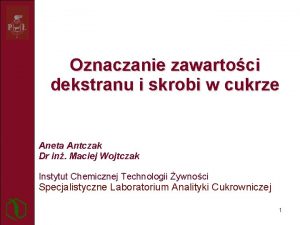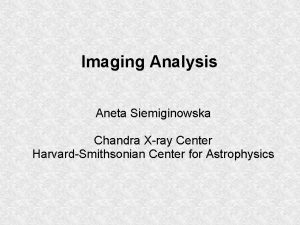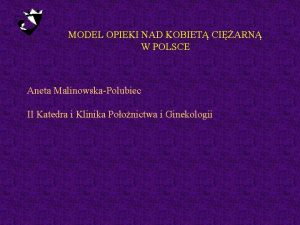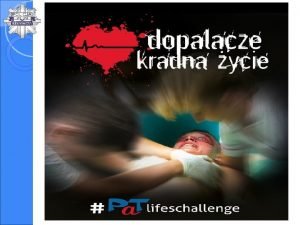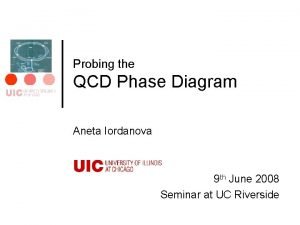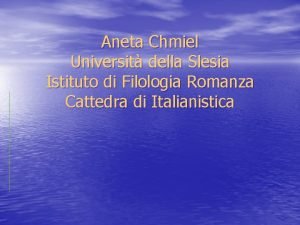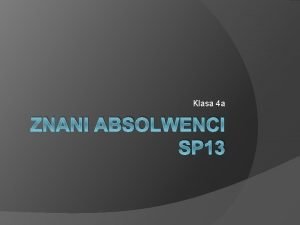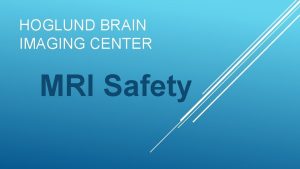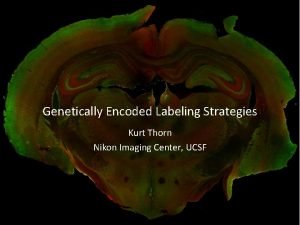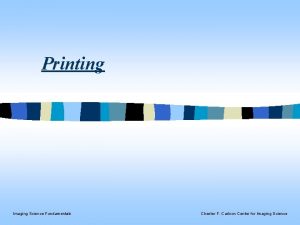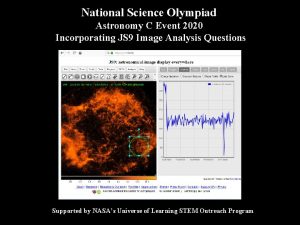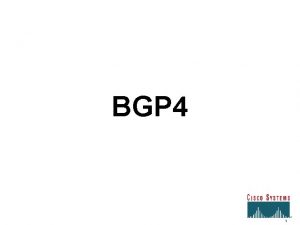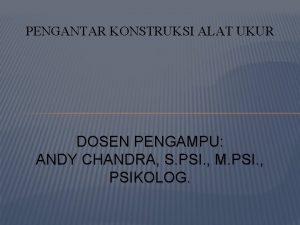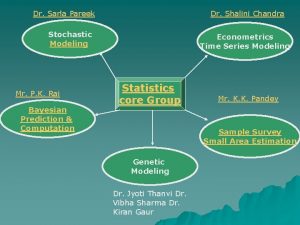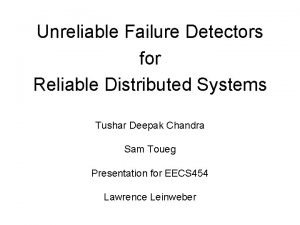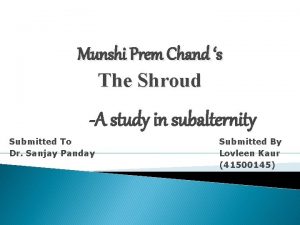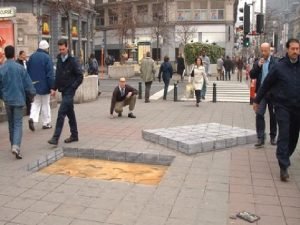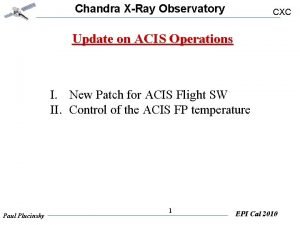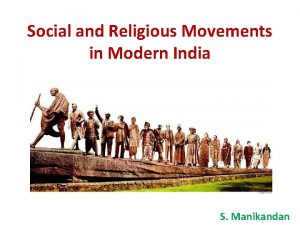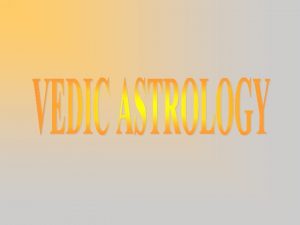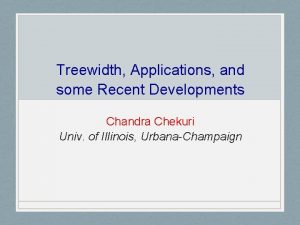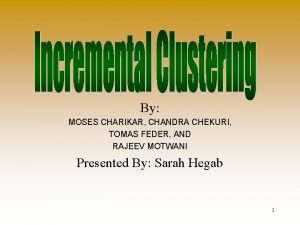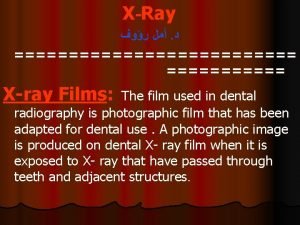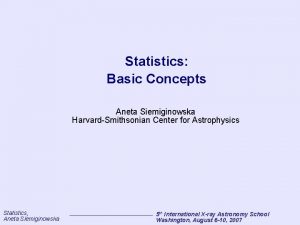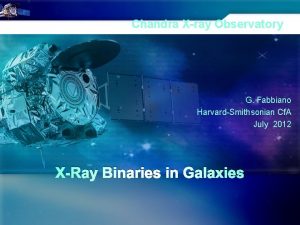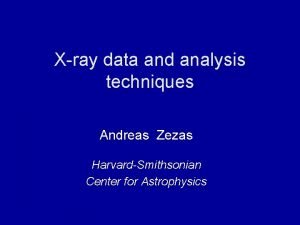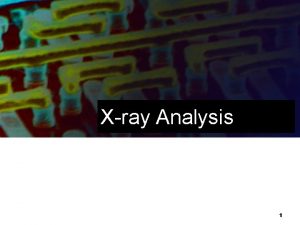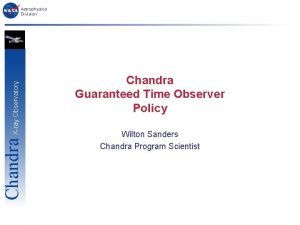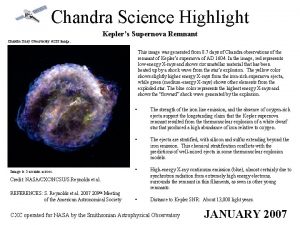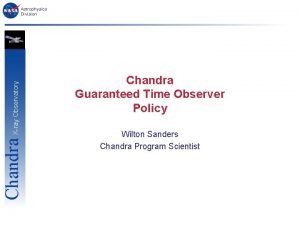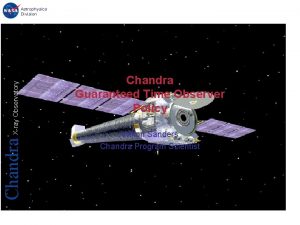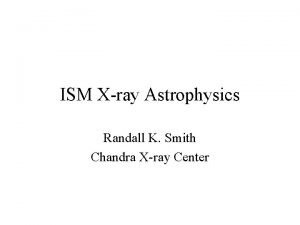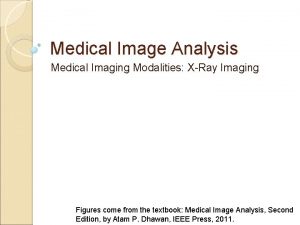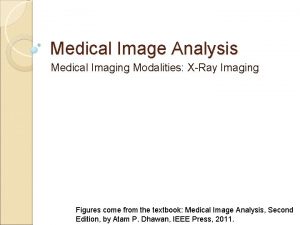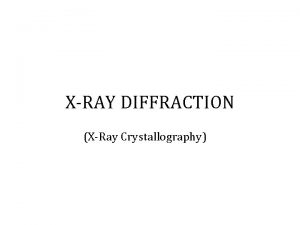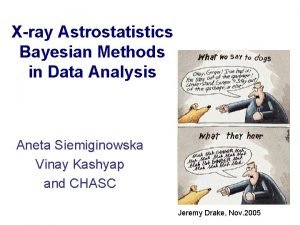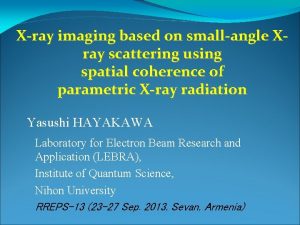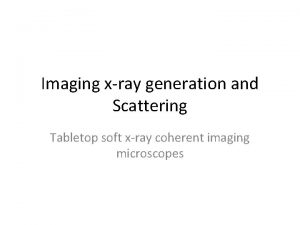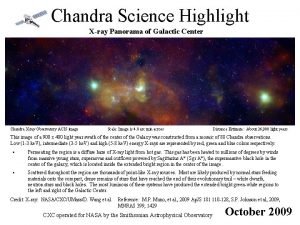Imaging Analysis Aneta Siemiginowska Chandra Xray Center HarvardSmithsonian















![Detector Coordinates: dmcopy "evt. fits[bin det=16]" det_by_16. img ds 9 det_by_16. img Detector Coordinates: dmcopy "evt. fits[bin det=16]" det_by_16. img ds 9 det_by_16. img](https://slidetodoc.com/presentation_image/00cf767b6343a34d3c3f8b1df9ba03da/image-16.jpg)

































- Slides: 49

Imaging Analysis Aneta Siemiginowska Chandra X-ray Center Harvard-Smithsonian Center for Astrophysics

What are the goals of Image Analysis in Astronomy? ● Create a nice picture. ● Understand the nature of the source: ● ● ● Understand the shape and size of the emitting regions Understand temperature distribution, velocity density distribution, composition and metallicity etc. Differentiate between emission processes. Understand energy and power involved in the observed emission Evolution of the source and how it relates to other sources.

First X-ray Imaging Telescope The Einstein Observatory (HEAO -2) Nov. 1978 -April 1981 High Resolution Imager Energy: 0. 15 -3 ke. V 5 -20 cm 2 FOV ~25 arcmin Effective Area Angular resolution ~6 arcsec! Tycho Supernova Remnant (1572) Credit: HEASARC

XMM Newton Launched in Dec. 1999 Energy Range: 0. 1 -15 ke. V Effective Area: 1500 cm 2 at 1 ke. V FOV ~27 -33 arcmin Angular resolution ~6 arcsec Tycho Supernova Energy resolution: E/DE ~et al (2000) Aschenbach

CHANDRA X-ray Observatory ● Launched in July 1999 ● Energy Range: 0. 1 -10 ke. V ● Effective Area: ● ACIS-I ~ 500 cm 2 ● HRC-I ~ 225 cm 2 ● ● ● FOV: ACIS-I 16'x 16' HRC-I: 30'x 30' Energy Resolution: E/DE ~ 20 -50 at 1 ke. V Angular Resolution < 1 arcsec Tycho Supernova Color-coded image. Credit: CXC

Angular Resolution Einstein XMM FWHM ~ 6 arcsec Chandra FWHM ~ 0. 5 arcsec

Galactic Center GRANAT/SIGMA in high energy X-rays and gamma-rays 30 -100 ke. V 100 -1000 ke. V Credit: SIGMA team 14 x 14 deg field Angular resolution: 10 arcmin

Summary I will use CIAO software in image analysis. (but see IRAF, FTOOLS, XIMAGE, XSPEC) * Difference between Image and the Event file? Binning options * Display data in different coordinates, detector vs. sky * Understanding the instrument. * Instrument characteristics * Detecting sources building the source list for further spectral analysis excluding the sources for the extended source analysis * PSF effects * Radial Profile * 2 D fitting in Sherpa * Smoothing the image * Image Reconstruction and Deconvolution

Event list and Binning PRISM view of the Event file.



X-ray Images ● Intensity Maps ● ● Raw vs. Smoothed images ● ● ● color represents energy Temperature maps ● ● true counts per pixel average counts/pixel True/False color images ● ● color represents variations in the intensity Color represents temperature Images from different bands: Xrays/radio/optical

Perseus A CHANDRA ACIS-S Smoothed Raw Color coded Fabian et al (2000)

Perseus A X-ray/Radio Optical Fabian et al (2000)

Coordinates and WCS SKY DET
![Detector Coordinates dmcopy evt fitsbin det16 detby16 img ds 9 detby16 img Detector Coordinates: dmcopy "evt. fits[bin det=16]" det_by_16. img ds 9 det_by_16. img](https://slidetodoc.com/presentation_image/00cf767b6343a34d3c3f8b1df9ba03da/image-16.jpg)
Detector Coordinates: dmcopy "evt. fits[bin det=16]" det_by_16. img ds 9 det_by_16. img

Instrumental Features ● Understanding the instrument: ● CCD is different than microchannel plate ● Bad pixels or columns: ● Hot pixels, node boundaries ● Trail images

Chandra ACIS Mc. Dowell 2001

Mc. Dowell 2001

Instrument Characteristics ● Exposure Maps ● Background: instrumental and cosmic ● Point Spread Function (PSF)

Exposure Maps Includes: detector quantum efficiency (QE), non-uniformity across the detector (QUE), mirrors vignietting, bad pixels and columns, chip gaps etc. Units [cm 2 cts /photon] CHANDRA ACIS Filtered

Exposure Maps Mc. Dowell 2001

CHANDRA Image of Tycho Supernova S = Data / (Exp. Map*Exp. Time) Credit: CXC

Point Spread Function ● ● ● Describes the shape of the image produced by a point source (delta function) on the detector: “blurring” Depends on photon energy and the location on the sky in respect to the optical axis of the telescope. Usually consists of the core and wings => dynamic range

CHANDRA PSF 5 arcmin off-axis

CHANDRA PSF offaxis 10 arcmin

Chandra/HRMA on axis PSF Encircled Energy: Fraction of Counts enclosed within the area of a given radius. ● Energy dependent: 0. 277 ke. V ● @ 0. 277 ke. V 95% in 1'' @ 9. 7 ke. V 75% in 1'' 9. 7 ke. V Radius (arcsec)

ACIS-S data Simulated PSF Fruscione et al 2002

Analysis Challenges ● ● PSF needs to be included in the X-ray analysis. PSF variations across the detector have to be taken into account in any multi-scale analysis. PSF affects determination of a shape of the source. Separation of overlapping sources: ● ● ● Size and boundaries of each source Luminosity of each source Pile-up modification of the PSF

Background ● Background radiation is common to X-ray detectors: ● ● ● Background due to diffuse X-ray background emission => contribution from unresolved sources Charged particle background => non-X-ray background Unrecognizable source contribution (trail images)

Chandra ACIS

Analysis Challenges ● ● ● Non-uniformity of the background radiation. Time-Variability in background intensity. Spurious events not recognized as background and interpreted as source.

CHANDRA ACIS BACKGROUND FI CCD BI CCD Effect of a Charged Particle Event

Energy Dependence of Non-X-ray Background Chandra ACIS-S

Variability and Background Flares Chandra ACIS-S CXC/CAL TIME

Radial Profile Data Simulated PSF Fruscione et al 2002

Profile in FITS format: NW-Region SE -Region Fruscione et al 2002 Excluded

Fitting Radial Profile in Sherpa Fruscione et al 2002

Image Fitting in Sherpa * Read data: binned image * Read error image or use Sherpa statistics * Display image “image data” * Filter the image using ds 9 or supply 2 D filter * Define 2 D models * Use PSF as a model or convolution kernel * Use Exposure Maps

Image Data PSF Model Residuals

Create a Nice Picture! => Smoothed Images Convolution of an Image with a kernel function usually: Gaussian, Box or Top Hat (wavelet) => aconvolve in CIAO CSMOOTH – adaptive smoothing with circular Gaussian or Top. Hat kernel functions. NGC 4038/39

X-ray Image of the Galactic Center CHANDRA ACIS 2 -8 ke. V Red: 23. 3 ke. V 3. 3 -4. 7 ke. V Green: Blue: 4. 7 -8 ke. V => Smoothed Image Exposure time 164 hrs 8. 4 x 8. 4 arcmin Baganoff etal (2003)

Multiscale Statistical Methods => Mirroring human visual and mental processes, in observing and interpreting phenomena simultaneously on multiple scales ● ● ● Multi-resolution methods => disentangle structures on different resolution scales in the observed image Includes wavelet transforms, adaptive smoothing, slicing of the image. Applications in Astronomy: filtering, image restoration, enhancements, image characterization.

Goals of Image Analysis ● ● What are the shape, size and boundaries of my source? “What degree of credibility is attached to the wispy arm structure we see emanating from the ring of supernova 1987 a? ” (Murtagh 1992) ● How real is the X-ray jet seen in the Galactic Center?

Galactic Center Chandra/ACIS (2 -8) Ke. V Questions: 1. Where is the supermassiv black hole in Galactic Center 2. Is the X-ray jet real? 1. 23 x 1. 23 arcmin Baganoff et al (2003)

Summary

Some typical Questions ● What is the flux of my source? ● What is the detection limit in my image? ● Modeling the surface brightness. ● Obtaining a source centroid. ● ● Is my source a point source? Is there an extended structure associated with this source? What is the statistical significance of this extended emission? What is the source shape?


 Aneta siemiginowska
Aneta siemiginowska Chandra aneta
Chandra aneta Frc driver station mac
Frc driver station mac Princeton imaging and analysis center
Princeton imaging and analysis center Aneta pyrgiel
Aneta pyrgiel Aneta malinowska polubiec
Aneta malinowska polubiec Aneta pawlińska
Aneta pawlińska Aneta langrová
Aneta langrová Aneta iordanova
Aneta iordanova Aneta chmiel
Aneta chmiel Aneta fojcik
Aneta fojcik Lyric hearing aid mri safety
Lyric hearing aid mri safety Ucsf nikon imaging center
Ucsf nikon imaging center Chester f. carlson center for imaging science
Chester f. carlson center for imaging science Sentara leigh wound clinic
Sentara leigh wound clinic Js9 imaging analysis software
Js9 imaging analysis software Jogotbondhu college
Jogotbondhu college Borun chandra
Borun chandra Okhil chandra sen
Okhil chandra sen Laltu chandra
Laltu chandra Kirti chandra sahu
Kirti chandra sahu Chandra cxc
Chandra cxc Ravi chandra cisco
Ravi chandra cisco Chandra o'ree age
Chandra o'ree age Dharnita chandra
Dharnita chandra Borun chandra
Borun chandra Chandra asri
Chandra asri Andy chandra s.psi m.psi
Andy chandra s.psi m.psi Chandra kavanagh
Chandra kavanagh Dr shalini chandra
Dr shalini chandra Tushar deepak chandra
Tushar deepak chandra The shroud by premchand analysis
The shroud by premchand analysis Father of indian english novel
Father of indian english novel Julian chandra
Julian chandra Research problem example for students
Research problem example for students Chandra gonzalez uh
Chandra gonzalez uh Chandra x-ray observatory acis
Chandra x-ray observatory acis Keshab chandra sen
Keshab chandra sen Satish chandra memorial school
Satish chandra memorial school Dr gopika chandra
Dr gopika chandra Bal chandra luitel
Bal chandra luitel 2amd15
2amd15 Tree decomposition
Tree decomposition Reggie chandra
Reggie chandra Chandra kavanagh
Chandra kavanagh Cnt 3004
Cnt 3004 Tomas feder
Tomas feder Siddharth chandra
Siddharth chandra Diploetic
Diploetic The tube side of the dental film packet
The tube side of the dental film packet
